
How Do Fast-Growing Professional Services Firms Outpace Their Peers?
New Research Shows Exactly How Professional Services Marketing Strategy Helps Leading Firms Beat The Competition
 The Hinge Research Institute recently published a study that uncovered the differences between high-growth professional services firms and average-growth firms. The data pointed directly at the way they market and sell their services. In fact, the difference was so dramatic that it seemed like sharing these insights might help some of you make the move to consider upgrading your marketing and sales execution, too.
The Hinge Research Institute recently published a study that uncovered the differences between high-growth professional services firms and average-growth firms. The data pointed directly at the way they market and sell their services. In fact, the difference was so dramatic that it seemed like sharing these insights might help some of you make the move to consider upgrading your marketing and sales execution, too.
How are we defining high growth? Good question. High-growth firms are those that experience 20% or more revenue growth year over year for a three-year period. The Hinge research highlighted 535 firms with over $1 million in revenue that provided the requested financials for a three-year period.
Here’s what you need to know to make sure you’re doing everything in your power to drive your professional services firm to higher growth.
The Percentage Of High-Growth Firms
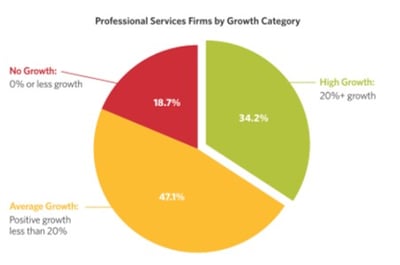
The Hinge research identified that 34.2% of the 535 professional services firms surveyed reported annual growth of 20% or higher over the three-year period (2015-2017). Many of the companies (47.1%) reported growth, but that growth was under 20% for the same three-year period. Finally, 18.7% of the companies reported no growth.
Numbers can be deceiving, so we investigated this a little more deeply. Of the companies experiencing high growth, their actual growth rate averaged 34.5%. The companies that realized modest growth grew at an average clip of 8.7%. The companies that showed no growth (or negative growth) checked in at an average of -.80%. The key here is that the fast-growing companies are outpacing their modest- or no-growth competitors significantly.
Here’s the $100,000 question: What are those high-growth companies doing differently than the companies experiencing low or no growth?
Investments In Marketing
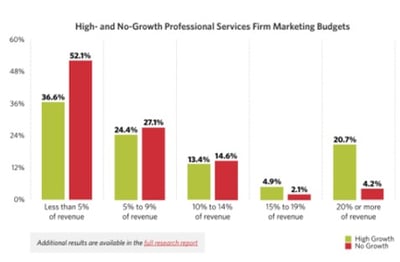 One of the most common questions our prospective clients ask is, “What should I be spending on marketing?” The answer becomes a little clearer when you look at this data.
One of the most common questions our prospective clients ask is, “What should I be spending on marketing?” The answer becomes a little clearer when you look at this data.
High-growth companies are far outspending their low- or no-growth competitors. The data from this research shows 20.7% of the high-growth companies are investing 20% or more of their annual revenue in marketing. Of the no- and low-growth companies, 52.1% are investing less than 5% of revenue in marketing.
This is a compelling case for the argument that if you want to grow, you have to invest heavily in that growth. The research also showed that 36.1% of the high-growth companies are investing less than 5% of revenue on their marketing. Keep in mind that if you’re a fairly large professional services firm, even 3% of revenue can still be significant. The data clearly shows that if you want to grow your firm more quickly, investing more money in marketing is an important part of the equation.
Specific Marketing Tactics Executed
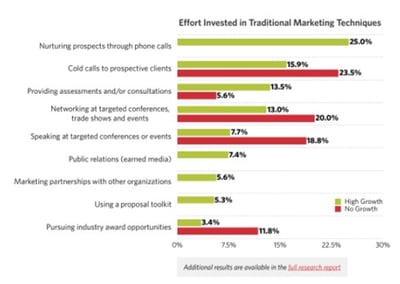 OK, you get it. If you want to grow, you have to do more and invest more. But what specifically are high-growth professional services firms doing with their marketing to fuel this high growth?
OK, you get it. If you want to grow, you have to do more and invest more. But what specifically are high-growth professional services firms doing with their marketing to fuel this high growth?
One of the major insights is the use of assessments or consultations. High-growth companies use this technique more than twice as often as the no-growth firms (13.5% vs. 5.6%), and this aligns with our own research. Providing prospects with value-added opportunities to talk with you about their business is key to getting people deep in their buyer journey to want to talk with you and your sales team.
It’s also clear that trade shows and conferences are used more by no-growth firms, with 20% of them saying they go to events like this, and only 13% of the high-growth firms investing in trade shows and conferences. This isn’t surprising, as high-growth companies are more interested in earning attention as opposed to renting it by attending a trade show or event.
What is surprising in the data is the amount of companies that are speaking at events (18.8% of the no-growth companies). This would indicate that despite speaking, they’re not leveraging the speaking opportunities to drive leads and better integrate that opportunity into their entire show strategy.<
The more you speak, the more leads you should generate, which should fuel growth. In our eyes, this is a disconnect, and it’s an opportunity to upgrade your trade show and event participation strategy to better connect the speaking engagement with the booth and lead gen activities.
Finally, the research does look at some non-traditional tactics, like PR or earned media, partnerships and proposal tool kits. This produced a usage rate of 7.4% on PR, 5.6% on partnerships and 5.3% on proposal tool kits for the high-growth companies, and again, zero usage for the no-growth companies.
All three of these tactics can be highly effective if used properly (especially the partnerships, which allow joint marketing and access to new audiences). The proposal tool kit is a great example of valuable content that you can use to help your prospects in their buyer journey while positioning your company as the trusted advisor and not the aggressive sales company.
Specific Sales Tactics Executed
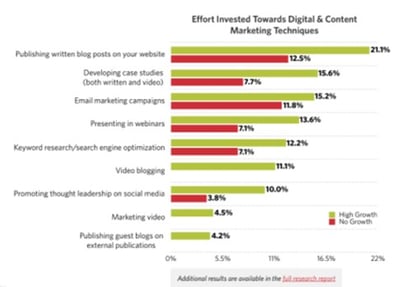 First, phone usage was identified as key, but perhaps not in the traditional sense. Only 15.9% of the high-growth firms mentioned using cold calling as a tactic, whereas 23.5% of the no-growth companies are still using cold calling as a sales technique. This aligns with our findings. Much better ways exist to use the phone than interrupting potential prospects.
First, phone usage was identified as key, but perhaps not in the traditional sense. Only 15.9% of the high-growth firms mentioned using cold calling as a tactic, whereas 23.5% of the no-growth companies are still using cold calling as a sales technique. This aligns with our findings. Much better ways exist to use the phone than interrupting potential prospects.
With that in mind, 25% of the high-growth firms did mention they use calling to nurture prospects, and the no-growth companies presented a big fat zero in this area. It’s clear that if you want to engage with your prospects, nurture is key. Prospects who connect with you through your website, prospects who share their contact information with you and prospects who attend events are all candidates for phone-based nurturing, if done correctly.
Top-Performing Digital Marketing Tactics
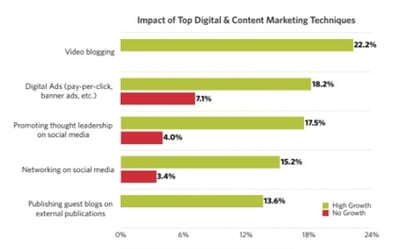 A variety of new-school marketing campaign techniques were discussed in the research. Using video (and video in the company blog, in particular) was by far the most impactful tactic, with 22.5% of high-growth companies calling this out as their most impactful tactic. Not surprisingly, no-growth companies are not doing anything with video and their blog.
A variety of new-school marketing campaign techniques were discussed in the research. Using video (and video in the company blog, in particular) was by far the most impactful tactic, with 22.5% of high-growth companies calling this out as their most impactful tactic. Not surprisingly, no-growth companies are not doing anything with video and their blog.
Display advertising on the web (including pay-per-click (PPC) ads and banner advertising) came in as the second most effective marketing tactic, with 18.2% of high-growth firms using this tactic compared to just 7.1% of the no-growth firms.
Social media also appears to play a much more prominent role in the high-growth professional services marketing game plan, with 17.5% of the firms posting thought leadership content on social media. Only 4% of the no-growth firms were investing in social media as a publication channel that can be leveraged to target new prospects for their firms.
Finally, since we’ve been talking about thought leadership, content marketing and thinking more like a publisher, 13.6% of the high-growth companies are actively publishing content and thought leadership on related websites in the form of guest blog articles.
This tactic checks a lot of boxes from a marketing effectiveness perspective. It drives new visitors to your website after your prospect has read compelling, educational and engaging stories. It puts them in the proper mindset to connect with your company and it drives backlinks to your site from other highly respected sites, which signals to Google that you have something valuable to say to people searching. Again, it's clear how companies drive higher growth with these types of tactics.
What Should You Do Next?
If you’re now considering upgrading your marketing effort to produce better revenue results, then the right question to ask is, “What should I do?” The research provides some clear insights around what types of tactics should be included in your marketing and where your marketing budget should be allocated.
Let’s start with your website. It’s no longer an electronic brochure that you update every few months with company information. Your website needs to be a portal for education. The experience must be top notch for visitors. You have just 10 seconds to tell you story when people land on your site.
Your blog is one of the most important aspects of your site. It's where your thought leadership is stored and it's where you can update your site with high-ranking educational content every day if you’re up for it. While 21% of the high-growth companies named their blog as one of their most important marketing tactics, only 12.5% of the no-growth companies mentioned blogging. Furthermore, 11% of the high-growth companies are doing video blogging, compared to none of the no-growth firms. Video and blogging are a match made in heaven when it comes to professional services marketing.
Content marketing, in the form of case studies, webinars and email marketing campaigns, plays a key role in highly effective marketing campaigns. These tactics are excellent at converting website visitors into leads. The high-growth companies are far outpacing the no-growth companies in use of these campaign tactics, and the results speak for themselves.
If you can’t be found on Google, Yahoo and Bing, then your firm is invisible. Search engine optimization (SEO) is a non-negotiable. The high-growth firms echoed that, too, as 12% are using it, while only 7% of the no-growth firms mentioned it as a tactic. In fact, the list of tactics in this chart represent a great place to start when it comes to building an action plan for upgrading your marketing. Blogging, webinars, case studies and content, search engine optimization, video marketing, email marketing, social media and content publication – they all represent a comprehensive set of tactics for any fast-growing company.
If you’re smart, you’re realizing this is a lot of stuff. It is, and all of that stuff has to be orchestrated like a symphony to produce the best prospect experience in your industry. This requires a strategy and experienced people. Don’t just jump in expecting your company to be able to do all of this out of the gate. Instead, spend some time planning and getting a comprehensive execution strategy together, and then bring in partners with experience doing this for other professional services firms.
Now you’re starting to think like a leader who is ready to take their revenue generation, marketing and sales to the next level, and move from a no-growth company to a high-growth company.
Square 2 Marketing – Revenue Is Earned With Experience, Methodology And Insights!

CEO and Chief Revenue Scientist
Mike Lieberman, CEO and Chief Revenue Scientist
Eliminate Hit-or-Miss Marketing Moves
Get advice, tips, tools and guidance to generate more leads for your company in this weekly email newsletter.



Eliminate Hit-or-Miss Marketing Moves
Get advice, tips, tools and guidance to generate more leads for your company in this weekly email newsletter.













